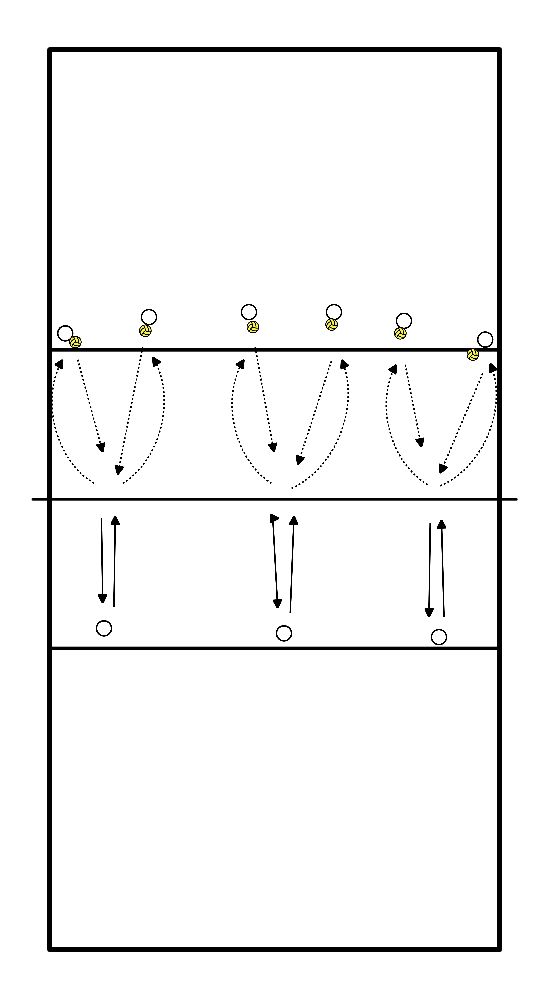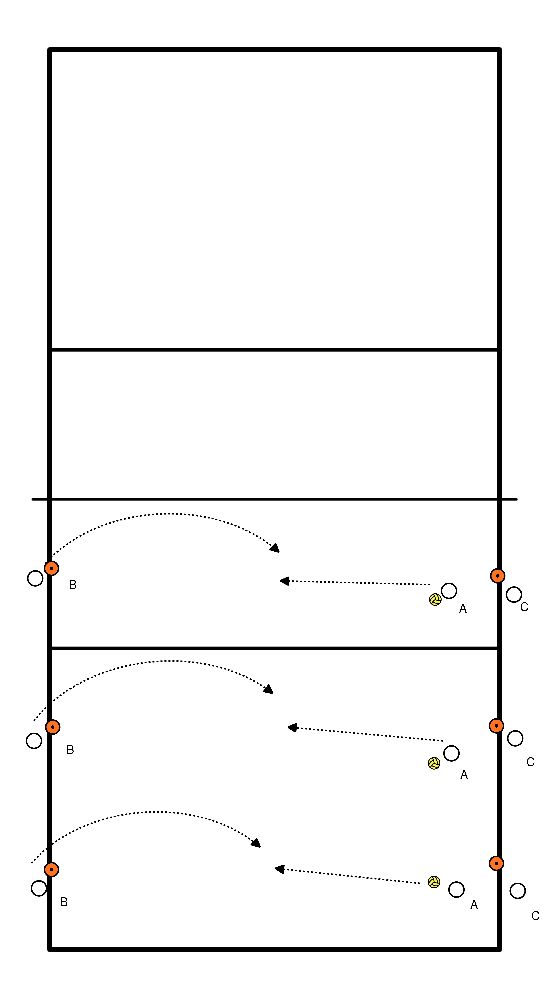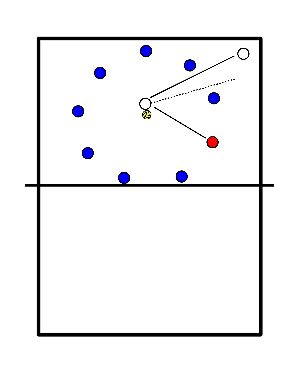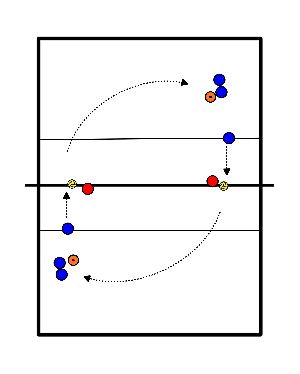Volleyball drills
You go in the running pass to the net and back to the back line.
- To the net you swing your left arm forward and back to the baseline your left arm back.
- Now you do the same as step 1 but with your right arm.
- Now you go heel-toe, this means that your heels have to touch your buttocks, you do this with a straight back (chest out) and your hands behind against your buttocks. You do this with a straight back (chest out) and your hands against the back of your buttocks.
- Now you are going to lift your knee, this is when you lift your knees to 90 degrees, the height of your hips. You do this with a straight back (chest out), towards the net and back to the baseline.
- You are now going to do the sideways pass, this means that you look with your body to one side and move sideways. You do this in the same way as the shuffle. When you go from the net back to the baseline you turn around again.
- Finally you do the cross pass, this means that you look with your body to one side and cross your legs, your arms move with you from left to right.
- player 1 at the net midfield
- number; players at mid-back with the ball
- row of players on the left (or right) side in front
- 2 corpses as disturbance/block on other side of the net
- 2 players as defence at the other side of the net
- player with ball throws to midfield
- midfield puts up HIGH
- left front attacks
- if hitting fails: play smart over the net
- if ball lands on the ground in the field you have a point
- Defenders try to prevent this.
- Everyone keeps on turning.
- Tackle becomes playmaker
- Defender joins the row of attackers
- Attacker passes under the net and becomes 1st defender.
- 2nd defender takes ball, passes under net and joins row of attackers
- 2 teams.
- Stand next to each other on all fours (rounded back).
- One player crawls under the others with the ball in front of him, at the end he rolls the ball back and stands on his own back.
- Then the next player etc. From sideline to sideline
- 2 opposite each other on the back line of both fields, 1 ball on the middle line.
- On signal of the trainer, sprint to the net, who has the ball first.
- This exercise can also be done with a dive first and then sprinting to the ball.
- 2 players with the ball at one side of the net on the 3 meter line, throw the ball in turn
- 1 player on the opposite side on the 3 meter line, this player makes the action
- walks to the net and plays the ball oh high to the player from whom the ball came
- runs backwards to the 3 metre line
- sessions of 10 movements and change

- per 3, 1 ball
- 2 cones per trio on the width of the volleyball field.
- player a runs in throws the ball high, player b runs in catches underhand and throws the ball high again, player c runs in and catches the ball underhand
- adjust to bra, reception or combinations of

This is always fun to do, especially the smaller kids like it.
- You have a monkey= This person is appointed by the trainer. This person must try to steal the coconut without getting caught.
- You have a coconut= This is basically just the volleyball, or another ball.
- You have a monkey hunter= This person is also assigned by the trainer, but the monkey hunter is ''undercover'', so he is just a palm tree but if the monkey has the ball in his hand, he may tap the monkey.
- And finally you have the Palm Trees= These are all the other players who are not the monkey or the monkey hunter.
You put all the players in a circle on one side of the field, in the middle of this circle you put the ''coconut''.
The trainer chooses the monkey in the presence of the whole team. The monkey then moves towards a wall or stands somewhere with its eyes and ears closed, facing the other way so it cannot see the team. You then say "The monkey hunter is....." (you point out the child, do not say the name of the child). If everyone knows who the monkey hunter is you say that the monkey can come back. The space between the palm trees where the monkey goes in the beginning, he must go back again.
For example, if the monkey goes between John and Peter in the direction of the coconut, it cannot go back between Hans and John.
If the monkey takes the coconut outside the circle without being tapped, the monkey wins.
If the monkey is tapped before it leaves the circle with the coconut, the monkey hunter has won.
- The blue balls are the "palm trees" players.
- The red dot is the ''monkey hunter''. The monkey does not know who the monkey hunter is. The monkey hunter is trying to tap the monkey.
- The white ball is the ''monkey''. He is trying to get the coconut without being tapped.
- The yellow ball is the coconut.

- Trainer stands at the net with a ball sticking out above the net
- Attacking run-up (short-long run) and watch arms swinging
- Make an offensive jump and try to touch the ball with the batting hand.
- Watch out:
- good posture
- good height
- arms well up
- Put down the close pass (brake pass) properly
- You can do this on both sides of the net, see picture. When you have completed the attack, pick up your ball and join the back of the line at the pawn.
- Red dots= Trainer
- Blue dots = players
- Orange dots= Pions
- Yellow dots= Volleyball
- Watch out:

Divide the players into 2 teams. Each team stands on one side of the net.
- On each side of the net there are a number of balls (depending on the size of the group you can add or subtract balls).
- The idea is that the players, once the starting signal is given, throw as many balls as possible to the other side.
- The team that has the most balls on its side of the net at the end of the game has lost.
- Each player may only play one ball at a time to the other side!
Variations for playing over/under the net:
- Roll with 2 arms
- Roll with 1 arm
- Overhead throw with 2 arms
- Overhead throw with stroke arm
- Overhand throw with non batting arm
- Bounce with 2 arms in front of the net so that the ball flies over the net after the bounce
- Bounce under the net (2 arms, later 1 arm, batting arm)
- 5 balls per player: place 4 balls in a diamond with 1 ball in the middle of the diamond.
- Players start behind their diamond and walk to the front,
- there they tap the middle ball,
- Then they move sideways (left or right) and tap the ball away.
- Move back to the middle of the diamond and then move sideways to the other side + tap the ball away.
- Then walk to the front, tap the ball away, back to the middle, backwards and tap the ball away.
- And finally tap the ball away in the middle.
- Groups of three players.
- Two behind each other, at four metres another one.
- The first one of the pair throws the ball to the player in front of him, this one does a check and then passes to the third player and so on.
- Pass the ball every time.
- 4 in attack with playmaker.
- Other side, 1 on reserve out of the field (right at position 1,2) and 3 in the pass and a dropout.
- The rest with ball on position 2 at the side of the attackers.
- These throw the ball to attacker who then pass the ball to SV and get a setup back.
- Attacking 3 defenders who pass to the offender.
- Reserve enters the field and the passers rotate.
- Last passer becomes receiver and receiver goes to line with ball.








